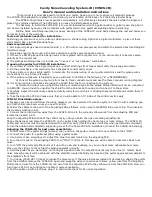
Chlorine analysis with the Cl module 5100
multi EA 5100
66
}
Enter the sample ID for all sample in the Name field.
}
Release all sequence lines
}
Confirm the entries with [OK].
}
Click the [Start Measurement] button.
ü
The prepared analysis sequence is processed.
For manual sampling, follow the instructions in the software.
8.3.3
Notes for measuring operations
CAUTION
Risk of respiratory problems due to leaking acetic acid vapors
The electrolyte solution of the "high sensitive" measuring cells contains high concentra-
tions of acetic acid.
¡
Ensure that the exhaust hose is connected to the measuring cell.
Check if the exhaust hose is connected to the "waste" outlet on the rear of the detec-
tion module, and that it is connected to the exhaust system.
¡
Before measurement operations, always close the front door of the detection mod-
ule and switch on the laboratory exhaust system.
WARNING
Risk of chemical burns
Concentrated sulfuric acid is used in the detection module as a drying agent. The con-
centrated acid can lead to severe chemical burns.
The 100 % acetic acid (glacial acetic acid), nitric acid and thymol used to create the elec-
trolyte solution can lead to severe chemical burns.
¡
Wear protective clothing when working with these hazardous substances.
¡
Observe all instructions and specifications in the safety data sheets.
¡
147).
The "sensitive" and "high con-
centration" measuring cells
Fill the measuring cells with fresh electrolyte solution daily:
¡
"sensitive" measuring cell: 15 to 20 ml
¡
"high concentration" measuring cell: 120 ml
The "high sensitive" measuring
cell
Fill the measuring cell daily with electrolyte solution: to approx. 65 ml
Change the electrolyte solution:
¡
Once per week
¡
If analytical problems occur
¡
If crystalline deposits form
Open the refill opening of the reference electrode during operation.
















































